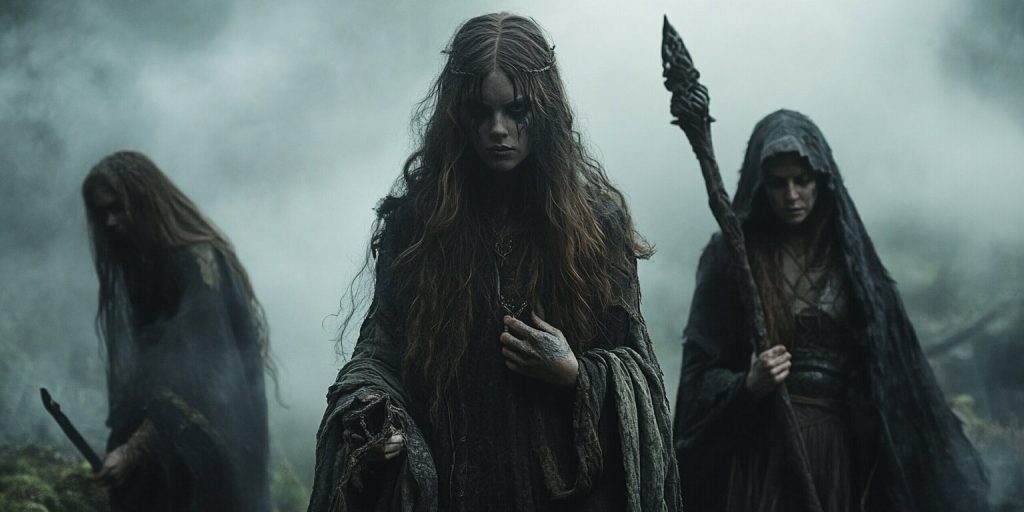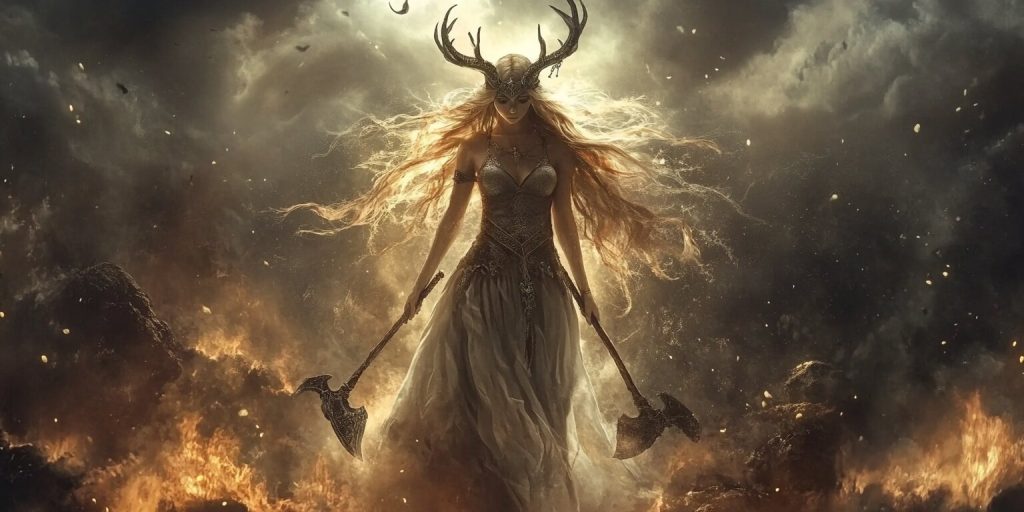Freya, Norse Goddesses, Norse Mythology, Vanir Goddesses
Myth and Magic: The Most Famous Norse Witches and Their Stories
Welcome to the world of Norse witchcraft. Here, myth and reality blend. Famous Norse witches are key figures in Norse mythology.
They were not just magic users but also revered as shamans in their communities. They helped shape Viking Age beliefs and norms. Let’s explore their stories, their connections to gods, and their impact on Viking culture.
Join us on a magical journey through ancient Scandinavia. Each tale will cast a spell of wonder and intrigue.
The Enigmatic World of Norse Witchcraft
Viking witchcraft is a fascinating world that blends with ancient Norse life. Witches were key in Viking society, moving between the every day and the mystical. People saw them in many ways, from respect to fear.
At the core of Norse magic are ancient rituals and beliefs. Witches used their powers for healing, divination, and protection. Their knowledge was shared through generations, adding depth to Viking culture.
- Seeresses, known for their prophetic abilities, guided the community with their visions.
- Sorceresses could control natural elements, working with nature and the gods.
Witches had a special place in Viking society. They connected the physical and spiritual worlds, showing a deep belief in magic. Norse magic and its practitioners showed a complex ancient view, where magic was part of daily life and intertwined with the beliefs of the Vikings.
Understanding the Role of Witches in Norse Society
The role of witches in Norse society was complex and deeply woven into Viking culture. These witches were healers, advisors, and spiritual leaders who helped people make tough decisions and face challenges.
Witches were also known for their healing skills. They used herbal remedies and ancient techniques. This made them very important for the health of their communities.
- Witches were revered for their magical practices and ability to connect with the spiritual realm.
- They often occupied a dual role as protectors and outcasts, simultaneously eliciting fear and admiration.
- Their practices included rituals to ensure fertility, prosperity, and protection from evil forces.
Despite their importance, people had mixed feelings about witches. Some respected them, while others were suspicious. This mix of feelings shows how vital witches were. They healed and connected with the spiritual beliefs of Viking culture.
Famous Norse Witches and Their Legendary Tales
Norse mythology is full of stories about famous witches. The völva is known for its powerful prophecies. These witches were important advisors to warriors and leaders.

They knew how to use seidr, an old magic that let them see the future and share prophecies, much like the seers described in Viking sagas.
Stories of the Powerful Völva
The völva connected humans to the gods. Their stories tell of their quests for wisdom. They shared this wisdom with those who asked.
Legends say a völva could see battles and their outcomes. This made them very important in Norse society. People respected them a lot, considering them vital figures in their saga of life.
Seeresses and Their Prophecies
Seeresses were also key in Norse mythology. They used divination to understand omens and signs, helping communities deal with life’s unknowns.
Their prophecies guided many and helped shape decisions that changed lives. The wisdom of these seresses is still remembered today.
The Influence of Norse Mythology on Witchcraft
Norse mythology is key to understanding Norse witches. It shows how gods and goddesses, like Thor, are tied to magic in Norse beliefs, revealing a deep bond between the divine and magic.
Gods like Odin inspired witches in Norse culture. He was all about knowledge and magic. His journey taught him seiðr, a magic form linked to witchcraft.
Reading the Poetic Edda helps us see how gods shape magic views. It shows how myths influence witchcraft.
- The divine connection makes Norse witches powerful in Viking beliefs.
- Seeresses are seen as wise, offering insight and foresight.
- Freyja, the goddess of love and fertility, links witchcraft with femininity, guiding many rituals.
Norse mythology and witchcraft create a rich culture. It’s all about respecting supernatural powers. Exploring these ties helps us see how gods and goddesses shape witchcraft traditions.
Witchcraft Rituals in the Viking Age
The Viking Age was filled with witchcraft traditions. Seiðr was a key part of Norse magic. It involved deep rituals to connect with spirits and gain powers.
Seiðr: The Art of Norse Magic
Seiðr rituals required the practitioner to enter a trance. They used chants, drumming, and special objects. Wands or staves were used and carried deep meanings connected to ancient Nordic traditions.
People saw Viking witchcraft differently. Some respected those who practiced seiðr for their powers, while others saw them as dangerous. Yet, seiðr was crucial for connecting with the divine and nature.
The Connection Between Norse Witches and the Gods
Norse witches and the gods had a deep connection. This connection was key to their magic, particularly in the practices of the Aesir and Vanir traditions. It helped them perform their rituals better and showed them to be important in the community.
- Witches saw themselves as messengers between gods and humans. They worked closely with gods like Odin and Freyja.
- Odin was known for his wisdom. Witches called on him for insight into the future.
- Freyja was all about love and fertility. Witches asked for her help to make their spells work.
This bond made witches special in Norse society. They were seen as important because they could talk to the gods, which helped them understand fate and the gods’ will.
The connection between witches and gods, particularly the Aesir and Vanir, shows a big part of Norse beliefs. It shows how important divine guidance was for these magical people.
Famous Norse Witches: Tales of Power and Mystery
Norse mythology is filled with stories of magic, love, and chaos. Gryla and Freya are two famous witches. They show different sides of witchcraft and magic.
Gryla: The Giantess and Her Dark Magic
Gryla is known for her dark magic and scary ways. She’s a giantess who eats naughty kids. Her stories teach about the dangers of bad behavior.
Freya: The Goddess of Love and Magic

Freya is different from Gryla. She’s the goddess of love and magic. People seek her help for love and magic. Her stories show magic’s power to create and destroy.
The Tools of the Trade: Wands, Staves, and Ritual Objects
Norse witches used many tools in their magic, like wands and staves, which are often mentioned in Old Norse sagas. These tools were more than just objects. They were believed to carry magical powers. Each tool was special and thought to have spiritual energy that helped the witch.
- Wands: Made from wood, wands helped direct energy in spells. They were extensions of the witch’s will, enabling focus and intention.
- Staves: Staves were taller than wands and used for grounding energy. They helped connect with the earth. Norse witches used them in ceremonies for stability and strength.
- Ritual Objects: In addition to wands and staves, Norse witches used crystals, herbs, and bones. Each item had its role in spells and rituals, adding depth and power.
The power of these tools came from their magical beliefs. Through rituals, they connected the physical world to the magical one. Using wands, staves, and other objects showed how Norse witches worked their magic. Each ceremony was a mix of intention, tradition, and spiritual connection.
The Impact of Norse Witches on Viking Culture
Norse wizards and witches were key in Viking culture, especially among the Aesir and Vanir. They were seen as healers, guides, and advisors. Their wisdom helped people deal with life’s challenges.
Their magic was not just about spells. It was about connecting the physical and spiritual worlds, and this connection was celebrated in many rituals.
In Viking communities, witches’ wisdom guided decisions, reflecting the values of the Aesir and Vanir. This shows a society that valued mystical knowledge. Women played important roles in leadership.
These witches led ceremonies for fertility, harvest, and protection. Their role was crucial in Viking culture.
Today, Norse witches’ stories are still loved. They appear in books, art, and movies. Their magic lives on, showing our deep interest in the unknown.

